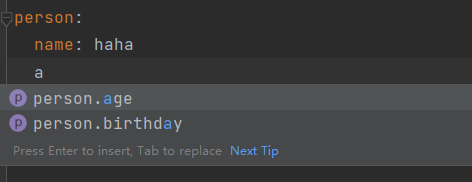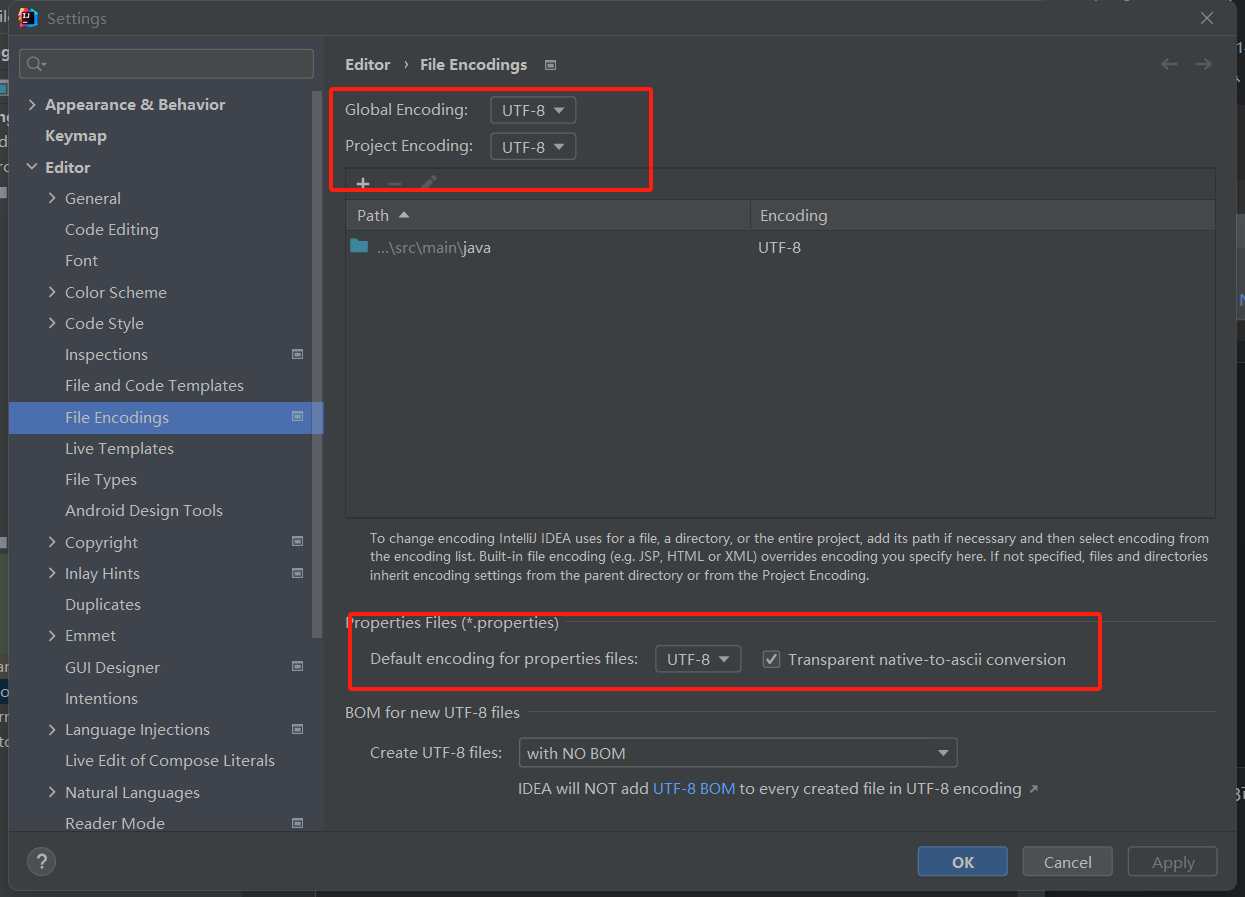SpringBoot配置文件
一、概述
SpringBoot 使用一个全局的配置文件,配置文件名称固定:
application.properties
application.yml
且 .properties 的优先级高于 .yml,当没有 .properties 时会使用 .yml 中的配置
使用配置文件可以修改 SpringBoot 自动配置的默认值,SpringBoot 在底层会给我们配置好。
二、YML
1、yml语法
1.基本语法
key: value表示一对键值对,空格必须要有
key: key1: value1 key2: value2用空格的缩进来控制层级关系,左对齐的一列数据都是同一级,有点类似Python
属性和值大小写敏感
2.值的写法
字面量: 普通值(数字、字符串、布尔值)字符串可以不加引号,使用kv直接来写
(1)单双引号
加上引号时需要注意:
\"\" : 会进行字符转义,双引号中有 \\n 就会换行,有 \\t 就相当于 tab 键
\"偷吃 \\n 闪光弹\"输出:偷吃闪光弹\'\' : 不会进行字符转义 ,单引号中有 \\n 就是 \\n,有 \\t 就是 \\t
\'偷吃 \\n 闪光弹\'输出:偷吃 \\n 闪光弹(2)对象和Map
k: v——在下一行来写对象的属性和值的关系;注意空格和缩进
map: kua: 8 tua: 6也可以在同一行内写出,使用花括号({})
map: {kua: 8,tua: 6}(3)数组
k: v——在下面多行中来写值;注意空格和缩进
firends: - zhangsan - lisi - wangwu也可以在同一行内写出,使用方括号( [] ),并使用逗号或者-隔开
friends: [zhangsan,lisi,wangwu]三、配置文件注入
1、配置文件注入
创建JavaBean,Person和Dog
@Component 将JavaBean 交给 Spring容器 管理
@ConfigurationProperties 告诉 SpringBoot 将本类中的所有属性和配置文件中相关的配置进行绑定
prefix = \"person\" 说明配置文件中哪个属性与该类中的属性进行映射
JavaBean 是容器中的组件,才能使用容器提供的 @ConfigurationProperties功能
// Person.java@Component@ConfigurationProperties(prefix = \"person\")public class Person { private String name; private Integer age; private boolean Boss; private Date birthday; private HashMap map; private ArrayList list; private Dog doggy; // Setter and Getter // toString() // Person()} // Dog.java@Component@ConfigurationProperties(prefix = \"dog\")public class Dog { private Integer age; private String name; // Setter and Getter // toString() // Person()} 导入配置文件处理器
org.springframework.boot spring-boot-configuration-processor true编写配置文件时 ,可以看到提示信息

person: name: haha age: 18 Boss: false birthday: \"2002/12/1\" map: {tua: 1,kua: 2} list: [1,4,6,8] doggy: name: goffy age: 3properties配置文件在idea中默认utf-8可能会乱码,修改 Idea 设置

测试类测试是否注入成功
@SpringBootTestpublic class PersonTest { @Autowired private Person person; @Test public void testPerson(){ System.out.println(person); }}输出:
Person{lastname=\'haha\', age=18, Boss=false, birthday=Sun Dec 01 00:00:00 GMT+08:00 2002, map={tua=1, kua=2}, list=[1, 4, 6, 8], doggy=Dog{age=3, name=\'goffy\'}}
2、@Value 和 @ConfigurationProperties 获取值比较
@ConfigurationProperties
@Value
功能
批量注入配置文件中的属性
一个个指定
松散绑定
支持
不支持
SpEL
不支持
支持
JSR303数据校验
支持
不支持
复杂类型封装
支持
不支持
1.松散绑定
Person 中有属性 private String firstName,使用@ConfigurationProperties 可以
person: first_name: John而使用@Value 的话,则需要完全一致绑定
@Value(\"${person.first_name}\")// 此处必须和配置文件中保持一致private String firstName;2.数据校验
添加字段 email,将 @Validated 放在类或方法参数上,配合字段上的 @Email,就可以在 Spring 应用中自动校验邮箱格式是否合法。否则,@Email 不会自动执行任何校验逻辑。两者配合,才能完成自动参数校验。
// Person.java@Component@Validated@ConfigurationProperties(prefix = \"person\")public class Person { private String name; private Integer age; @Email private String email; private Date birthday; private HashMap map; private ArrayList list; // Setter and Getter // toString() // Person()} 3.@PropertySource加载指定的配置文件
@PropertySource 用于加载配置文件(通常是 .properties 文件),将其中的配置属性加载到 Spring 容器中。这是 Spring 中经典的加载外部配置文件的方式,通常用于普通的 Spring 项目。
在 Spring Boot 中,通常推荐使用 application.properties 或 application.yml 文件来配置项目属性。但在某些特殊场景下,你可能希望加载额外的属性文件,或者通过其他方式管理配置文件。此时,可以使用 @PropertySource 注解来加载指定的配置文件。
这里有个 person.properties 文件
person.last-name=John Doeperson.age=30person.boss=true可以在JavaBean中通过 @PropertySource 加载这个配置文件
@PropertySource(\"classpath:person.properties\") // 加载person.properties文件@Component // 使该类成为Spring管理的Beanpublic class Person { @Value(\"${person.last-name}\") private String lastName; @Value(\"${person.age}\") private Integer age; @Value(\"${person.boss}\") private Boolean boss; // Getters and Setters}@PropertySource(\"classpath:person.properties\") 告诉 Spring 容器去加载 person.properties 文件中的配置。
@Value(\"${person.last-name}\") 将 person.properties 文件中的配置项与类的字段进行绑定。
Spring 会自动注入配置文件中的值
4.@ImportResource导入传统 Spring XML 配置文件
@ImportResource 用于导入传统的 Spring XML 配置文件。Spring Boot 默认没有 XML 配置文件,而是通过注解方式来配置 Bean,但有时我们仍然需要使用 XML 配置文件。这个注解就是用来导入这些 XML 配置文件的。
现有的 Spring 项目或者第三方库使用了 XML 配置,你可以在 Spring Boot 项目中通过 @ImportResource 来加载这些配置。
有 beans.xml 配置文件
在 Spring Boot 配置类中使用 @ImportResource 加载该配置文件
@Configuration@ImportResource(\"classpath:beans.xml\") // 导入XML配置文件public class AppConfig {}@ImportResource(\"classpath:beans.xml\") 会加载 beans.xml 文件中的配置内容,并将其注册到 Spring 容器中
5.@Bean 注入
@Bean 注解用于标记一个方法,这个方法会返回一个对象,并将这个对象添加到 Spring 容器中作为一个 Bean。@Bean 注解是 Spring 中传统的注解方式,通常用在 @Configuration 注解的配置类中。
在 Spring Boot 中,通常推荐使用组件扫描(@Component, @Service, @Repository, @Controller 等注解)自动注册 Bean。但如果你需要在配置类中明确控制 Bean 的创建过程,或者你没有使用注解进行标记的类时,可以使用 @Bean 注解手动注册 Bean。
有一个 HelloService 类,并想要通过 @Bean 注解将其注册为 Spring 管理的 Bean
@Configurationpublic class MyAppConfig { // 通过@Bean注解将HelloService对象注册到Spring容器 @Bean public HelloService helloService() { System.out.println(\"配置类@Bean给容器中添加组件了...\"); return new HelloService(); }}@Bean 注解的 helloService() 方法返回一个 HelloService 实例,Spring 会自动将这个实例作为 Bean 管理。
@Configuration 注解标记的类表明这是一个配置类,类似于传统 Spring 中的 XML 配置文件。
Spring 会通过 @Bean 注解的返回值将 HelloService 添加到容器中
四、Profile
1、多Profile文件
1.Profile的作用
Spring Boot 支持多种 profile(配置环境),使得在不同环境下加载不同的配置。你可以根据开发、测试、生产等不同的环境使用不同的配置文件。
Spring Boot 可以使用不同的配置文件来根据不同的 profile 加载不同的配置。
2.激活Profile
(1)在配置文件中指定
在 application.properties 或 application.yml 中,指定 spring.profiles.active 来激活某个 profile。例如,指定 dev 环境
spring.profiles.active=dev(2)命令行参数
在运行 Spring Boot 应用时,通过命令行指定 spring.profiles.active 参数
java -jar your-app.jar --spring.profiles.active=dev(3)虚拟机参数
还可以通过在启动时指定虚拟机参数来设置
java -Dspring.profiles.active=dev -jar your-app.jar3.多文档块
YAML 配置文件支持多个文档块,每个文档块可以定义不同的配置
# application-dev.ymlserver: port: 8080spring: profiles: active: dev---# application-prod.ymlserver: port: 9090spring: profiles: active: prod2、配置文件加载参数
Spring Boot 会从以下位置依次加载配置文件:
- file:./config/:从当前目录的 config 子目录中加载。
- file:./:从当前目录加载。
- classpath:/config/:从类路径下的 config 目录加载。
- classpath:/:从类路径的根目录加载。
1.优先级
加载配置文件时,Spring Boot 会按照优先级从高到低加载,高优先级的配置会覆盖低优先级的配置。例如:
命令行参数 > JNDI属性 > Java系统属性 > 环境变量 > 外部配置文件 > 内部配置文件。
├── SpringBootDemo5│ ├── config│ │ ├── application1.properties│ ├── src│ │ ├── main│ │ ├── java│ │ │ ├── com.goose│ │ ├── resources│ │ ├── config│ │ │ ├── application2.properties│ │ ├── application3.properties│ ├── application4.properties四个配置文件优先级如下:
排名
文件名
加载路径
优先级说明
1
application1.properties
file:./config/
最高优先级
,覆盖其他所有
2
application4.properties
file:./
第二优先级
3
application2.properties
classpath:/config/
第三优先级
4
application3.properties
classpath:/
最低优先级
3、外部配置加载顺序
Spring Boot 支持从多个位置加载配置文件,且优先级从高到低,配置会形成互补:
java -jar app.jar --server.port=8087 --server.context-path=/abc命令行参数:通过命令行启动时指定配置项,优先级最高。
- 来自 java:comp/env 的 JNDI 属性:从 JNDI(Java Naming and Directory Interface)中获取配置。
- Java 系统属性:通过 System.getProperties() 获取的属性。
- 操作系统环境变量:通过操作系统环境变量获取的配置。
- random.* 配置:通过 RandomValuePropertySource 配置的随机值。
- 外部的 application-{profile}.properties 或 application-{profile}.yml 文件:比如 application-dev.properties,会根据当前的 profile 加载。
- 内部的 application-{profile}.properties 或 application-{profile}.yml 文件:如果是内部的文件,优先级会低于外部文件。
- 外部的 application.properties 或 application.yml 文件。
- 内部的 application.properties 或 application.yml 文件。
- 通过 @Configuration 注解类的 @PropertySource 注解加载的配置文件。
- 通过 SpringApplication.setDefaultProperties() 设置的默认属性。
4、自动配置原理
自动配置是 Spring Boot 的核心特性之一,它可以根据项目的依赖自动配置许多常见的功能,减少手动配置的工作量。
- 启动时加载主配置类:Spring Boot 会加载一个配置类,通常是标注了 @SpringBootApplication 的主类,并开启了自动配置功能(@EnableAutoConfiguration)。
- @EnableAutoConfiguration 注解:这个注解告诉 Spring Boot 启用自动配置功能,自动根据项目的依赖加载适合的配置。
- 自动配置过程:
-
扫描 META-INF/spring.factories:Spring Boot 会扫描所有 jar 包中的 META-INF/spring.factories 文件,加载其中配置的自动配置类(EnableAutoConfiguration)。
-
自动配置类的配置:自动配置类包含了许多常见的配置。例如,HttpEncodingAutoConfiguration 类会为 Web 项目自动配置 HTTP 编码功能。
-
-
自动配置条件:自动配置类通常会使用 @Conditional 注解,只有满足特定条件时,才会生效。例如:
-
@ConditionalOnClass:当类路径中存在特定的类时,自动配置才会生效。
-
@ConditionalOnProperty:当配置文件中存在特定属性时,自动配置才会生效。
-
@Configuration@EnableConfigurationProperties(HttpEncodingProperties.class)@ConditionalOnWebApplication@ConditionalOnClass(CharacterEncodingFilter.class)@ConditionalOnProperty(prefix = \"spring.http.encoding\", value = \"enabled\", matchIfMissing = true)public class HttpEncodingAutoConfiguration { private final HttpEncodingProperties properties; public HttpEncodingAutoConfiguration(HttpEncodingProperties properties) { this.properties = properties; } @Bean @ConditionalOnMissingBean(CharacterEncodingFilter.class) public CharacterEncodingFilter characterEncodingFilter() { CharacterEncodingFilter filter = new OrderedCharacterEncodingFilter(); filter.setEncoding(this.properties.getCharset().name()); filter.setForceRequestEncoding(this.properties.shouldForce(Type.REQUEST)); filter.setForceResponseEncoding(this.properties.shouldForce(Type.RESPONSE)); return filter; }}
- @ConditionalOnWebApplication:表示只有当应用是 Web 应用时,自动配置才生效。
- @ConditionalOnClass(CharacterEncodingFilter.class):表示只有当 CharacterEncodingFilter 类存在时,自动配置才生效。
- @ConditionalOnProperty:表示当配置文件中没有明确指定该属性时,自动配置仍会生效。
5、条件注解
Spring Boot 提供了多个基于条件的注解,用于判断是否满足条件时才进行自动配置。
必须是@Conditional指定的条件成立,才给容器中添加组件,配置里面的所有内容才生效
@Conditional扩展注解
作用(判断是否满足当前指定条件)
@ConditionalOnJava
系统的java版本是否符合要求
@ConditionalOnBean
容器中存在指定Bean;
@ConditionalOnMissingBean
容器中不存在指定Bean;
@ConditionalOnExpression
满足SpEL表达式指定
@ConditionalOnClass
系统中有指定的类
@ConditionalOnMissingClass
系统中没有指定的类
@ConditionalOnSingleCandidate
容器中只有一个指定的Bean,或者这个Bean是首选Bean
@ConditionalOnProperty
系统中指定的属性是否有指定的值
@ConditionalOnResource
类路径下是否存在指定资源文件
@ConditionalOnWebApplication
当前是web环境
@ConditionalOnNotWebApplication
当前不是web环境
@ConditionalOnJndi
JNDI存在指定项
自动配置类必须在一定的条件下才能生效;
我们怎么知道哪些自动配置类生效;
我们可以通过启用 debug=true 属性;来让控制台打印自动配置报告,这样我们就可以很方便的知道哪些自动配置


